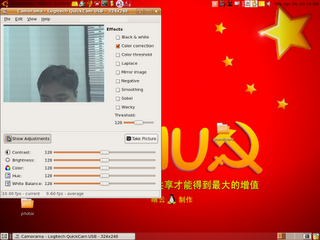Warning: TAGLISH
Wow, super busy ako ng mga nakaraang linggo kaya halos wala na akong time na makapagblog man lang. Pero ok na rin kasi sobrang daming nangyari at dami ko ding natutunan...
Last week, nag-attend ako sa isang Advanced Linux Training Seminar na sponsored ng National Computer Center at ng aming office para sa eLGU project. Ginanap ito sa NCC mismo sa UP Diliman. Gaya ng sabi ko, isa lang akong everyday Linux desktop user kaya napakabasic pa lang talaga ng mga alam ko kaya excited akong umattend.
Ilan lang sa mga natutunan ko ay ang mga sumusunod: mga bagay-bagay tungkol sa Logical Volume Management, Software Raid, sa Xserver at Xorg, sa Cron, booting process, troubleshooting at marami pang iba. Ang gamit pala namin sa training at RHEL 4 kasi tiga Touch Solutions ang nagturo.
Mayroong binigay na parang troubleshooting test nung last day (tslocal, tsnetwork, tsboot). Ang sabi ng instructor eh, iyong last at tanging trainee na galing sa isang LGU daw na nakatapos ng lahat ng mga exercises na iyon eh sa batch the past year at inabot daw ng alas-siyete ng gabi. Weee! Natapos ko lahat before 5 pm! At ako lang nakatapos sa batch namin! Yabang?! Oo, pero happy lang ako kasi ako lang ang hindi computer engineer o kumuha ng computer related course sa batch namin eh...
Nag-attend din ako ng Basic Linux Training conducted by the Development Academy of the Philippines kasi requirement sa Community eCenter project namin. Para akong tanga, at ang masakit.. ung mga batang instructor namin eh tinuring kaming lahat na tanga.
Oh well, I don't question their proficiency pero siguro they should consider na hindi lahat ng magiging estudyante nila eh pare-parehas na first time Linux user.
May itinanong ba naman ako dun sa isang instructor na nagkataong katabi ko... tapos hindi ako pinapansin pero after mga 3 times ako nagtanong... sinagot ba naman ako ng pabalang na "makinig ka sa nagsasalita sa harap para matuto ka ng Linux".
Dang! Puede naman siguro akong napagsabihan ng mas maayos di ba? And besides about Linux din naman ung tanong ko. Oh well, siguro magaling na talaga sila... pero still, I was offended kasi if I was in his case... hindi ako mambabastos ng estudyanteng nagtatanong.
Nasanay kasi ata ako sa Touch Solutions na kapag may naitanong ka eh sinisikap pa rin nilang sagutin kaya dami ko natutunan. Different people, different strokes.
At sa aking obserbasyon, base na rin sa training module na ibinigay nila... mukhang kulang ung training o hindi ito akma para magamit ang mga kaalamang ipinamamahagi upang magamit ito sa isang Community eCenter. May mga puntong may mas madali pang paraan na puedeng magamit upang madaling ma-absorb ng mga participants ang paggamit ng Linux sa desktop o puede ring kulang talaga ang dalawang araw para sa lahat ng topics na dapat pag-aralan.
Ang resulta? May balita ako na marami na sa mga Community eCenter sa iba't-ibang munisipyo ay nagpalit na nang piratang Windows sa kanilang mga PCs. Talagang nakakalungkot kasi pagkakataon na sana ito upang maimulat ang tao sa FOSS.
Ah basta kami sa Gerona, we'll push on with Kubuntu and Ubuntu para maimulat ang aming kababayan sa isang alternatibong mas ligtas gamitin, kadalasang legal na libreng gamitin at magdaragdag sa kanila ng ibayong kaalaman sa computers.
Balik sa Ubuntu, nakainstall ako today ng GyachE Improved. Hanep, deb package na siya. Isang Loell sa ubuntuforums.org na tiga-Davao ang nagpackage nito. Madali siyang install sa aking Ubuntu Dapper at may mga dagdag na features tulad ng puedeng irecord ang webcam session, etc. At mukhang hindi siya buggy hindi tulad ng Gyach Enhanced na kung saan kinuha ang project na ito.
Pero sana matapos na ang Gaim 2 kasi meron na din daw siyang webcam at voice capability, mas masaya na naman yun!
Sarap talaga ng Linux at Open Source, dami taong makikilala at daming bagay na puedeng matutunan.... hindi ka mauubusan!





